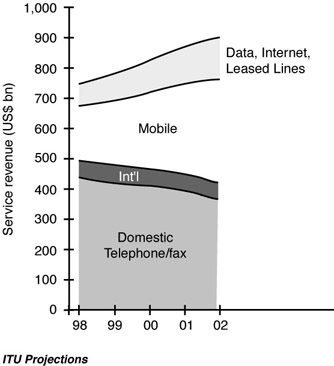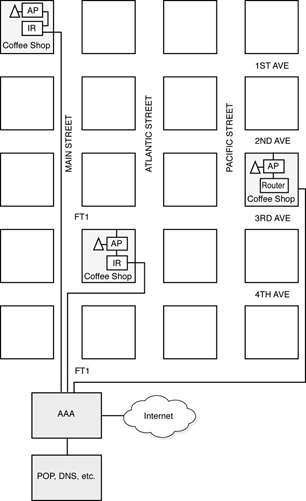Economics and Realities of Hotspot Services - A Provider s Perspective
|
|
Economics and Realities of Hotspot Services — A Provider’s Perspective
In 2001 and 2002, the telecom space saw carnage with dozens of companies filing for Chapter 7/11 and billions of dollars in investments and loans lost. Does this imply that telecom has no future? Far from it! One personal fact may illustrate why. I spent $33 a month in telecom-related services in the mid-1980s, but now spend more than $333 a month in all sorts of new services. The telecom industry is nearly a trillion-dollars-a-year industry (see Figure 1-24).

Figure 1-24: Worldwide revenues and percentage allocation
The problem is that the Competitive/DSL/Radio/Fiber Local Exchange Carriers (CLEC/DLEC/RLEC/FLEC) proponents and executives made erroneous statements about the business proposition, promising 80 percent gross margins with 40 percent net positive bottom lines in four years. Yet venture capitalists and financiers failed to practice due diligence and engage competent telecom professionals as project consultants who would have immediately challenged these erroneous statements. The reality is much more as follows. Telecom is a utility business, and investors who have an eight-year outlook will do well (if/when they choose companies/management/business propositions appropriately). The realities are more like 35 to 40 percent gross margins with 15 to 20 percent net positive return lines in seven to eight years.
Hotspot networks fall in the same category. Investors will not have 80 percent gross margins with 40 percent net positive bottom lines in four years; they will have 35 to 40 percent gross margins with 15 to 20 percent net positive return lines in seven to eight years.
Examples of Usage
Hotspot services can be designed to support indoor or outdoor applications, or a combination of both. Figures 1-25 and 1-26 give two examples.

Figure 1-25: Example of hotspot network (indoor application)

Figure 1-26: Example of hotspot network (outdoor application)
Basic Economics
When utilizing the RAIR concept development by the author, the equipment to support an outdoor hotspot network costs about $1,500 per location (for a simple indoor application, this figure is cut in half). Without using the RAIR concept (but using large centralized sectorized antennas), a typical 2,000 by 2,000 feet hotspot would cost $15,000 to $20,000 in equipment. Assuming a 30-month amortization, this is $50 a month. The T1/FT1 Internet line is approximately $1,000 a month. Hence, the network (transmission plus amortized equipment) cost per month is around $1,050. The operator could decide to use DSL services instead of the T1 line; this would result in a transmission cost figure of $50 to $100 a month, making the overall economics much more attractive. A 20 percent contribution (of the total) must also be added to sales, general, and administrative (SGA), a 20 percent contribution must be added to operations, and at least a 10 percent contribution must be added to net income. The carrier-level cost of a hotspot location is about $1,600 a month.
If a hotspot location supports 100 subscribers, the monthly fee for these subscribers must be $16. If only 50 subscribers can be supported/found, then the monthly fee must be $32.
If the hotspot users are transient in nature and only have weekly subscriptions, then the fees must be different. A hotspot supporting 400 transients a month requires a weekly fee (assuming one-week usage out of the month) of $4.00, and so on.
It is probably not likely that an operator can secure 100 customers in a hotspot. However, when properly designed (using the RAIR concept coupled with a DSL transmission mechanism), the hotspot has a breakeven with as few as 10 customers: $1,500 amortized in 30 months plus $50 for transmission, plus a 50 percent markup for perations, SGA, and profit, leads to a monthly expense of $150 — 10 customers each paying $30 per month can cover the expenses and provide a reasonable return.
The themes discussed in this chapter are expanded and elaborated on throughout the rest of this book. Emphasis is placed on practical guidelines rather than providing a complete survey of all of the available platforms and alternatives spanning the past 20 years and the next five.
|
|
EAN: N/A
Pages: 88